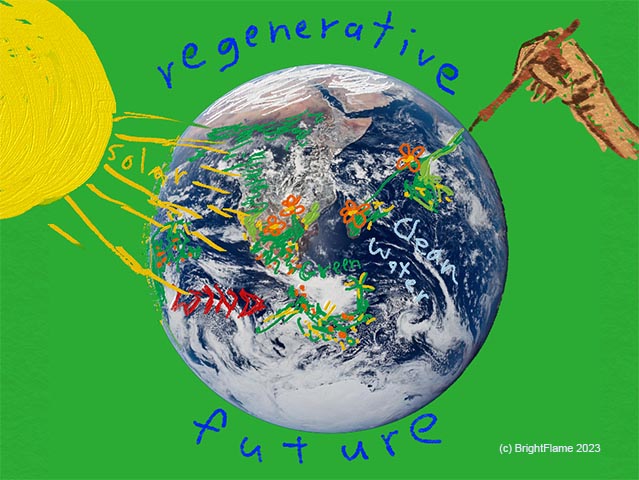by BrightFlame
How do we humans perceive the Web of Life? How do we develop reciprocal relationships with our Earth kin, human and non-? What and how do we know?
I explore these questions in my short speculative fiction featured in Solarpunk Creatures (World Weaver Press), Bioluminescent (Android Press), and Solarpunk Magazine (Issue 6). These stories relate to my two previous articles for the Center for Sustainable Futures:
“On Being the Earth” centers Indigenous Science (by its many names) and the reciprocal, interconnected relationships that sustain the Web of Life: why it’s best we humans de-center ourselves among all living beings.
I live, write, and teach aligned with solarpunk. My article “Towards Solarpunk Futures” contains lots of info and resources about the vibe. In short, we need to imagine the future we desire in order to create a trajectory. Solarpunk is not only hopeful futures where Nature and technology align and where cooperation and regeneration replace capitalism and extractive industry, it also imagines the way forward. Solarpunks create real forward-thinking projects. So the vibe is not only picturing bright futures, it’s getting us there. Solarpunk writing and projects continue to blossom worldwide—my article catches just a slice in time.
Lest you think solarpunk is all utopian, feel-good, sugar-coated writing (it’s not!), fellow educator and writer Rob Cameron writes in his essay “The Dark City as a Hot Place to Be: A Call for Solarpunk Noir” (Solarpunk Magazine, Issue 6): “Shaping [noir] into a solarpunk tool—a healing poultice made of venom, so to speak—is not so far fetched. In fact, it would be fun and an expedient means of quickly bringing solarpunk to the attention of a larger audience, which would help solarpunk have practical application beyond us first adopters and creatives.” He posits that solarpunk noir would uplift systemic agency rather than neoliberal individual agency that much climate fiction includes. Rob’s article is so much richer than my attempt to summarize it—I hope you’ll read it.
I also write lunarpunk, which I argue is not the opposite of solarpunk but a subset that includes more magic and spirituality among other elements. For instance, my story “When the Web Went Down” is featured in Bioluminescent (Android Press), touted as the first lunarpunk anthology. I’m among wonderful authors in this collection, including Neil Gaiman. As Publishers Weekly said in a glowing review, snap it up!
My essay in Honoring the Wild: Reclaiming Witchcraft and Environmental Activism, “Sprinkling Magic in the Mundane,” is both lunarpunk and solarpunk. I relay how writing and teaching for the Earth are the forms my activism take. The anthology, edited by Irisanya Moon, includes essays and exercises by those in my spiritual tradition, though is applicable to activism in general. As Irisanya says in the Introduction, they wanted to show: “what activism looks like from the inside. While the outside and the pictures and the outcomes and the victories and the disappointments are many, the emotions are just as mighty and many. The ‘why’ has always been more valuable than the ‘how’ to me. Because when you are clear on the direction, you will find a way to get there. When your heart is the compass, the journey reveals itself.”
2024 update: I'm thrilled to announce my debut novel, The Working, launches this summer. A modern coven must thwart a looming eco-cataclysm and find the key to the bright future we need. Readers hail The Working for its diverse characters, justice notes, ecofeminism, and real spiritual practice. It is lunarpunk with solarpunk notes. I hope you'll read it. You will find more info on all the above on my website: https://brightflame.com
Here’s to a hopeful, fruitful, healthy 2024 and beyond for all living beings of the Earth—including us humans.
